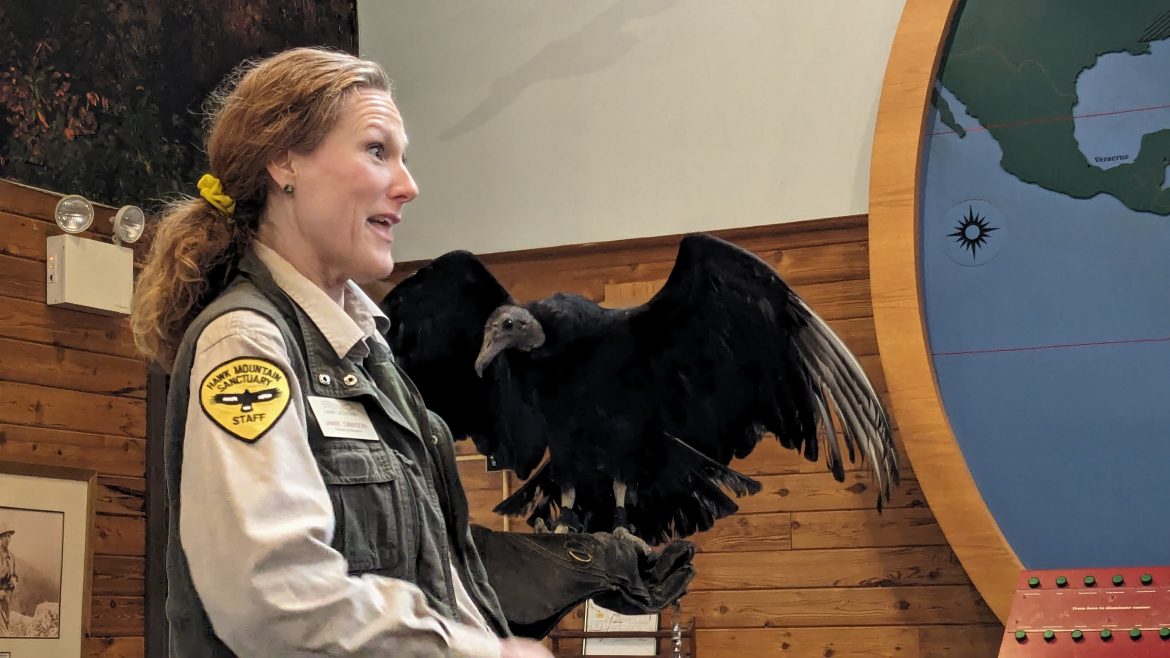
There’s nothing like meeting a raptor up close and personal to inspire someone to care for them, says Jamie Dawson, the Hawk Mountain Sanctuary’s education director. Image: Daniel Schoenherr
By Daniel Schoenherr
Editor’s note: This is one in a series of stories coming out of a recent meeting of the Society of Environmental Journalists in Philadelphia.
Tucked away in the foothills of Appalachia lies Pennsylvania’s Hawk Mountain Sanctuary — a center for environmental education and a flyway for thousands of raptors each year.
Society of Environmental Journalists members attending their recent conference in Philadelphia caught the beginning of the raptor migration season at Hawk Mountain. Jason Hall of Philadelphia’s In Color Birding Club led the reporting tour.
In Color helps diverse communities recognize the potential of Philadelphia’s underfunded green spaces and see the magic of immersion in the state’s natural environment, Hall said.
Hawk Mountain “is a very special spot along the Appalachian Trail because of its conservation studies,” he said. “We bring out our In Color club here quite often and people love it every time of the year.”
Hall wanted SEJ members to see the magic, too. The “Revolutionary Raptors: Hawk Mountain’s Role in Equity and Ecology” tour took members down the mountain’s primary sanctuary trail to see passing birds at lookout spots with expansive views.
“People are coming all the way to Philadelphia to talk about climate change’s impact on nature,” he said. “Why not get you guys out of Philadelphia a little bit? This is a great trail for it.”
Hawk Mountain Sanctuary’s senior research biologist, Dave Barber, explained the significance of the group’s hawk migration count each spring and fall.

Hawk Mountain Sanctuary Senior Research Biologist Dave Barber answers questions from members of the Society of Environmental Journalists on April 4, 2024. Image: Daniel Schoenherr
“Many raptors have really large home ranges so you can’t monitor a population very easily,” he said. “The best way to do that is through counts at migration corridors like Hawk Mountain.”
In 1960, the sanctuary’s bald eagle counts were used as evidence in Rachel Carson’s Silent Spring, Barber said. Data on the declining maturity of the documented eagles helped pinpoint the source of their population decline: unborn chicks.
The sanctuary has taught for decades about the significance of preserving habitat for raptors through outreach and group learning programs, said Sean Grace, Hawk Mountain Sanctuary’s president.
“In the 1990s, we wanted to expand our mission and what we do,” he said. “The three legs of the stool that hold up Hawk Mountain are the stewardship of sanctuary lands, science and studying and, of course, education.”
Jamie Dawson, the Hawk Mountain Sanctuary education director, presented the migration patterns and biology of Pennsylvania’s migrating raptors, complete with a live demonstration using three of the group’s raptors. As she spoke about the benefit of landowners having bird boxes on their property, a black vulture was perched on her arm.
“We have many awesome humans and we have many awesome raptor ambassadors on our team,” she said, referring to the sanctuary’s birds. “We want to inspire sanctuary guests to take direct conservation action for raptors.”
